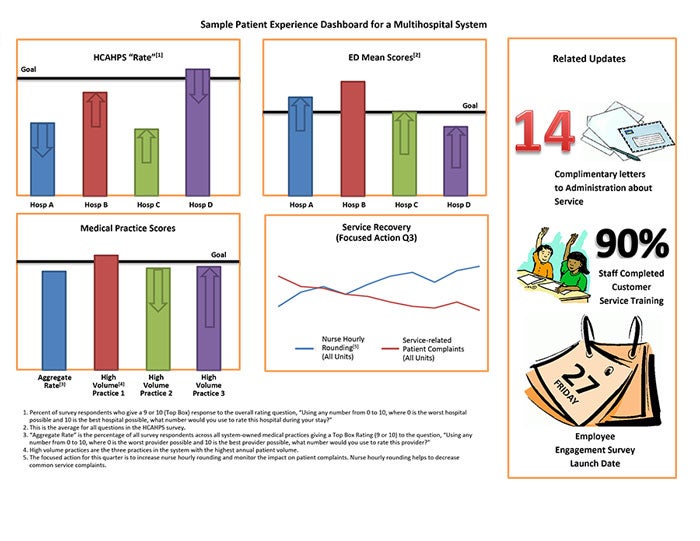
Performance Improvement
Stewards of the Patient Experience: Trustees’ Key Role
Boards should set expectations, understand the metrics and ask key questions
By Kristin Baird
Trustee Talking Points
- Trustees must understand how the patient experience advances the organization’s mission, vision and values.
- Delivering a consistently positive customer experience across the continuum of care is a business imperative.
- Under value-based purchasing, hospitals are measured and rewarded for achievement and consistency.
- Some patient experiences can make or break the reputation and financial well-being of the entire organization.
Trustees play a vital role in governing strategy and business operations of the health care organizations they serve. For this reason, it is essential that they understand the importance of the patient experience and how it advances the mission, vision and values (MVV) of the organization.
Trustees represent the voice of the community and are stewards of a valuable community asset. In their role as stewards, there must be accountability for delivering the highest quality care to patients while maintaining a positive, trust-evoking reputation. In many cases, board members and their families are users (patients) of the health care organization they serve. Given all these ties, the board has a vested interest in ensuring a consistently positive patient experience.
Setting Expectations
Board members should expect operational leaders to anchor the patient experience in the MVV and brand promise. After all, every touch point a patient has should affirm the mission in action. It is gaps between the stated MVV and the actual experience that create patient disappointment, dissatisfaction and distrust.
Set an expectation that the administration appoint an executive sponsor(s) for the patient experience who will provide regular updates to the board on experience metrics. The executive sponsor should be accountable for setting the patient experience strategy, but will need adequate resources to ensure execution across the system. The board can support the success of the patient experience strategy by approving the allocation of necessary resources.
Delivering a consistently positive customer experience across the continuum of care is a business imperative. In any business it is essential in creating and sustaining the brand integrity, but in health care, where trust is paramount, there are no second chances. Unlike other fields, health care is a relatively new believer in the importance of customer service. It is now being embraced as a core business strategy with a newly emerging discipline — Chief Experience Officer or CXO. While many organizations don’t have a CXO, more and more are designating an experience manager or director to oversee the function.
In 2016 Deloitte published a report, “The Value of Patient Experience: Hospitals with Better Patient-reported Experience Perform Better Financially.” The paper states, “Improving the patient experience can help a hospital improve its financial performance by strengthening customer loyalty, building reputation and brand, and boosting utilization of hospital services through increased referrals to family and friends. Furthermore, research has shown that better patient experience correlates with lower medical malpractice risk for physicians and lower staff turnover ratios.”
The research showed that a 10 percentage-point increase in the number of respondents giving a hospital a “top-box” (9 or 10 out of 10) rating is associated with an increase in net margin of 1.4%.
Understanding Key Metrics
Goals aimed at ensuring quality and safety are high priorities for boards. In this age of value-based purchasing (VBP), hospitals are evaluated and rewarded on clinical processes of care, efficiencies, outcomes and the patient experience of care. The patient experience of care is measured through a standardized tool, Hospital Consumer Assessment of Healthcare Providers and Systems (HCAHPS). Under VBP, hospitals are rewarded for achievement, improvement and consistency in each of eight areas measured, including:
- Nurse Communication
- Doctor Communication
- Responsiveness of Staff
- Medication Communication
- Pain Management
- Cleanliness/Quietness
- Discharge Information
- Overall
- Likeliness to Recommend
While HCAHPS provides a publicly reported score, data is typically at least nine months old and only measures inpatient experiences.
Many health care organizations engage outside vendors to administer patient satisfaction surveys and report the results. These vendors provide more up-to-date information as well as much deeper insight into the experience beyond the prescribed HCAHPS questions. In addition, they collect comments and valuable benchmark data allowing an organization to compare performance against peer groups.
Because boards oversee inpatient as well as multiple outpatient points of care delivery, members will need to understand metrics that measure patient experience across the system, including:
- EDCAHPS — Emergency Department
- CGCAHPS — Clinicians and Groups
- OAS CAHPS — Ambulatory Surgery [voluntary reporting]
- HH-CAHPS — Home Health and Hospice
Keep in mind that medical practices and emergency services are the front doors to the entire system; patient experiences here can make or break the reputation and financial well-being of the entire organization. Access to care is often the first touch point in the patient experience with the system. In its 2018 Consumer Health Insights Survey, McKinsey found that access to care, when and where consumers want it, is important in the total experience. Therefore, understanding access is important to the board’s understanding of the experience. Consumers want shorter wait times for appointments and quicker access to appointments.
Beyond the patient satisfaction metrics, boards shouldn’t ignore the connection with staff engagement. Deloitte found that highly engaged staff likely boost patient experience, translating into better performance. For this reason, boards can gain a deeper understanding of the patient experience by understanding the employee experience as well. Administration should be expected to conduct comprehensive employee engagement surveys along with pulse surveys to keep abreast of meaningful trends in staff engagement. Survey vendors who do both patient satisfaction and employee engagement surveys can show correlation between the two, helping to identify departments and service lines at risk for attrition.
According to a Press Ganey report published in the Harvard Business Review in April 2019, hospitals that improve over time in distinct HCAHPS measures or in employee engagement also improve in the overall ratings of care. But when hospitals improve both, the improvement effect on overall ratings is compounded. The analysis really focuses on the impact of improving both the specified HCAHPS measures (Nurse Communication was used in the analysis) and employee engagement on hospitals’ financial resources. For this reason, board members are wise to pay attention to both the patient satisfaction scores as well as employee engagement scores.
Using Dashboards and Stories
Many organizations struggle with what information to share with the board and in what format. Dashboards provide a simplified, visual tool for quickly summarizing data from multiple sources and can show the current state as well as meaningful trends.
The sample dashboards shown here, provide examples for a multihospital system as well as a single community hospital. Boards can use these sample dashboards and the “Key Questions Trustees Should Ask” in the sidebar to this article to help identify key patient experience metrics that are most important to monitor for their own organizations.
In addition to surveys, social media sites provide a wealth of opinions from community members. There are several tracking tools available that monitor star ratings and comments made about organizations in the various social media channels. This is becoming increasingly important to monitor as consumers turn to social media reviews to guide their decisions about choosing physicians and hospitals. While social media monitoring is typically housed in the marketing department, it is useful to include the score in the patient experience dashboard as well.
Trustee Takeaways
Board members should take the following actions toward fulfilling their key role as stewards of the patient experience:
- Become familiar with CAHPS measurement and the effect on reimbursement.
- Set the expectation that metrics will be presented to the board on a consistent basis and in a concise, easy-to-read format.
- Know the process for handling negative comments from the public.
- Identify opportunities to integrate patient experience into existing committees. (For example: Present patient satisfaction metrics at meetings of the Quality Committee. Report reimbursement related to patient experience and CAHPS to the Finance Committee.)
- Ask questions and speak up about patient satisfaction issues.
Because health care is a deeply personal human service, numeric data isn’t the only metric that sheds light on the patient experience. Stories are a great way to move the data from the head to the heart. Reserve a few minutes during each board meeting where administrators or department heads can share a story or two of great service or read a letter from a patient describing their experience. Stories are a powerful way to anchor the patient experience to the mission and remind everyone of the important work that is being done.
As members of the community themselves, trustees hear the good, the bad and the ugly about patient experiences from other community members. Board members have a role in ensuring that high-quality service is delivered to the community while also representing the voice of the community in the boardroom. This role can create a balancing act — and the temptation to get dragged into the neighbor’s drama when listening to complaints. Board members are most helpful when they are prepared to respond, not react, when hearing negative comments about patient experiences. That means listening, acknowledging and assuring the person that their concerns will be shared with the appropriate people. Individual trustees should not try to solve the problem or micromanage the follow up.
Board members have a responsibility both to the community member and the hospital administration to pass along compliments as well as concerns or complaints about patient experiences so they can be handled through the appropriate channels. The key is to understand and follow the appropriate reporting process and trust that timely actions will be taken.
Playing a Supporting Role
Board members can support the organization’s efforts to improve the patient experience by serving on committees focused on that goal. Many health care organizations have patient and family advisory councils to bring the voice of the patient into operational decisions. Serving as an ad hoc member of the patient and family advisory board is a good way to stay connected with consumer needs and represent those needs in the decision-making process.
Board involvement in patient experience doesn’t necessarily require a unique board committee. Members can leverage existing committee work by reviewing patient experience metrics as part of the quality committee.
Remember that the patient experience is a reflection of the organizational culture. It is imperative that the board and administration work to create and sustain a culture that fosters engaged employees and providers who will deliver the best possible patient experience.

